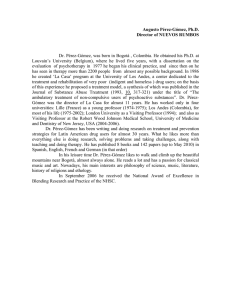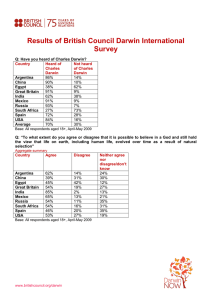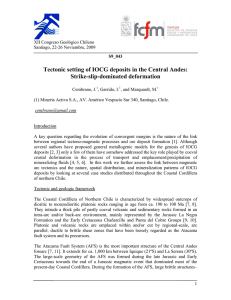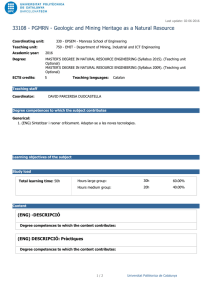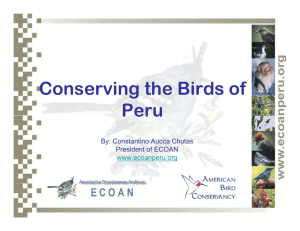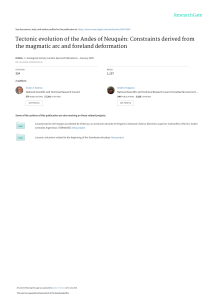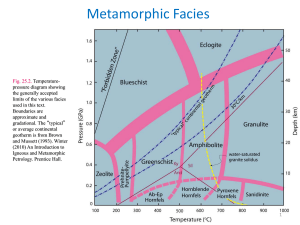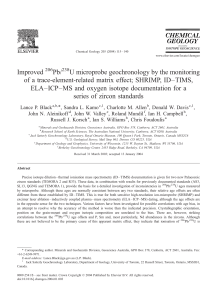Doubly-vergent structures in metamorphic rocks that enclose the
Anuncio
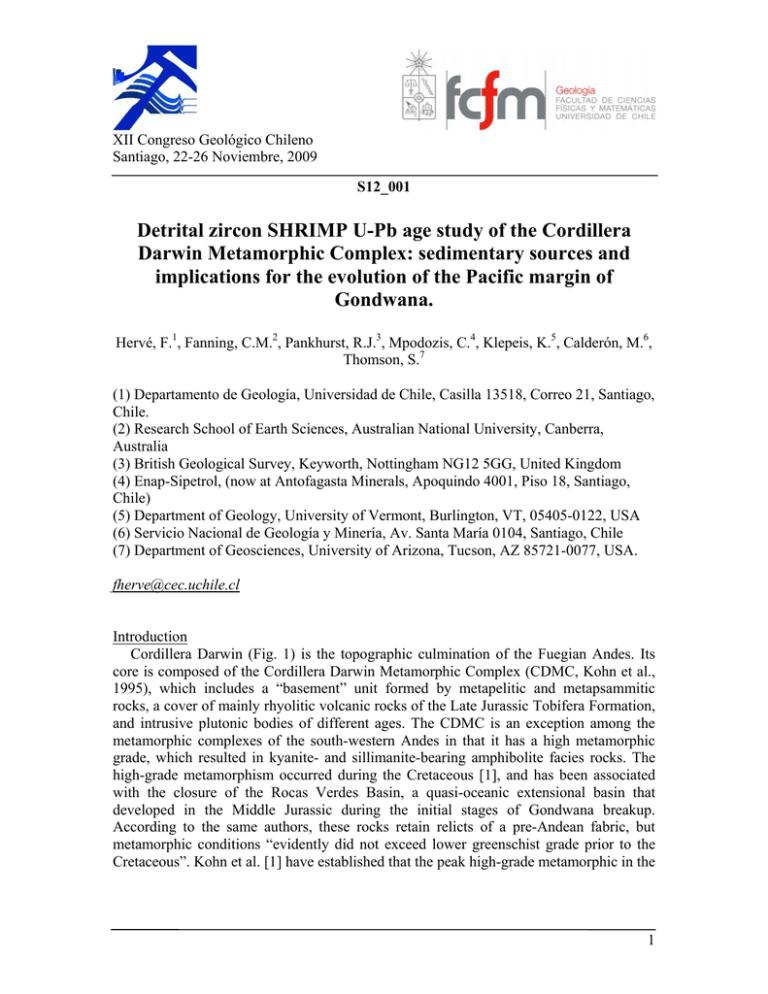
XII Congreso Geológico Chileno Santiago, 22-26 Noviembre, 2009 S12_001 Detrital zircon SHRIMP U-Pb age study of the Cordillera Darwin Metamorphic Complex: sedimentary sources and implications for the evolution of the Pacific margin of Gondwana. Hervé, F.1, Fanning, C.M.2, Pankhurst, R.J.3, Mpodozis, C.4, Klepeis, K.5, Calderón, M.6, Thomson, S.7 (1) Departamento de Geología, Universidad de Chile, Casilla 13518, Correo 21, Santiago, Chile. (2) Research School of Earth Sciences, Australian National University, Canberra, Australia (3) British Geological Survey, Keyworth, Nottingham NG12 5GG, United Kingdom (4) Enap-Sipetrol, (now at Antofagasta Minerals, Apoquindo 4001, Piso 18, Santiago, Chile) (5) Department of Geology, University of Vermont, Burlington, VT, 05405-0122, USA (6) Servicio Nacional de Geología y Minería, Av. Santa María 0104, Santiago, Chile (7) Department of Geosciences, University of Arizona, Tucson, AZ 85721-0077, USA. [email protected] Introduction Cordillera Darwin (Fig. 1) is the topographic culmination of the Fuegian Andes. Its core is composed of the Cordillera Darwin Metamorphic Complex (CDMC, Kohn et al., 1995), which includes a “basement” unit formed by metapelitic and metapsammitic rocks, a cover of mainly rhyolitic volcanic rocks of the Late Jurassic Tobífera Formation, and intrusive plutonic bodies of different ages. The CDMC is an exception among the metamorphic complexes of the south-western Andes in that it has a high metamorphic grade, which resulted in kyanite- and sillimanite-bearing amphibolite facies rocks. The high-grade metamorphism occurred during the Cretaceous [1], and has been associated with the closure of the Rocas Verdes Basin, a quasi-oceanic extensional basin that developed in the Middle Jurassic during the initial stages of Gondwana breakup. According to the same authors, these rocks retain relicts of a pre-Andean fabric, but metamorphic conditions “evidently did not exceed lower greenschist grade prior to the Cretaceous”. Kohn et al. [1] have established that the peak high-grade metamorphic in the 1 XII Congreso Geológico Chileno Santiago, 22-26 Noviembre, 2009 CDMC occurred between 90 and 100–120 Ma, based on stratigraphical relationships, KAr and Ar-Ar metamorphic mineral ages, and the ages of cross-cutting plutons. The age and nature of the protolith of the CDMC basement is largely unknown. A Rb– Sr whole rock errorchron of 240±40 Ma was obtained for CDMC metamorphic rocks belonging to this basement unit from Bahía Pluschow by Hervé et al. [2]. Kohn et al. [1] suggested that the CDMC basement corresponds to a Paleozoic to lower Mesozoic (?) metasedimentary and metavolcanic unit, believed to have been originally deposited as an accretionary wedge on the pre-Mid Jurassic Pacific margin of South America [3]. An alternative possibility has been raised recently, suggesting that it is correlative with the Eastern Andes Metamorphic Complex, deposited in a passive margin environment and cropping out in the Patagonian Andes inboard of the coastal accretionary complexes. Methodology Field work was carried out during four seasons of boat cruises in the area. After petrographic inspection of over 100 samples, 16 were selected for isotopic analysis. Zircon concentrates were prepared at the Departamento de Geología, Universidad de Chile. The U–Pb SHRIMP ages determined during this investigation were obtained using SHRIMP I, II and RG at the Research School of Earth Sciences, The Australian National University, Canberra. The measurement techniques are similar to those of Williams [4], and references therein. Cathodoluminescence (CL) images were used through out to select areas for analysis. In the case of the detrital zircon analyses, CL images were used to locate the youngest component within any single zircon grain. Conclusions In order to assess the alternative models, we have determined U–Pb SHRIMP ages on detrital zircons from metasedimentary rocks from the CDMC with the particular aim to examine their possible provenance from the adjacent mainly (?) Cambrian basement of eastern Tierra del Fuego. Detrital zircon ages were also obtained from three low-grade metasedimentary rocks from the basal unit of the unconformably overlying Tobífera Formation, and from a granitic clast included in them, as further characterisations of the age of the CDMC from which they derive.The metasedimentary basement unit present in the Cordillera Darwin Metamorphic Complex, characterized by mainly Early Paleozoic detrital zircons as the youngest components, differs from the Cambrian meta-igneous basement of the Magallanes foreland basin. It also differs from the Duque de York Complex, part of the accretionary prism in the western archipelagos of Patagonia, in that the latter have a prominent Early Permian detrital zircon component. The detrital zircon patterns of the CDMC are more comparable to those of the Eastern Andes Metamorphic Complex further north in the Patagonian Andes, interpreted as having been deposited in a passive margin setting. However, at present, both areas are spatially separated by the Cambrian meta-igneous basement of the Magallanes foreland basin in Tierra del Fuego, and they cannot be considered to form a continuous rock body. The presence of 2 XII Congreso Geológico Chileno Santiago, 22-26 Noviembre, 2009 Ordovician detrital zircons and granitic clasts complicates the identification of the source areas, as granites of such ages are not known in southern Patagonia. The CDMC lies in the Scotia Plate, whose Cenozoic boundary with the South America plate is the left lateral wrench Magallanes–Fagnano fault system (MFFS). The detrital zircon patterns of the CDMC basement unit are more complex than if they had the exclusively Cambrian igneous source of the presently adjacent Magallanes foreland basin basement. This suggests that the two areas were not side-by-side during the Early Paleozoic, but that their amalgamation occurred prior to the Middle Jurassic, as indicated by Jurassic Tobífera volcanic rocks unconformably deposited over both basements. The MFFS was thus probably developed along the site of an older suture, located in the contact between the CDMC and the meta-igneous Cambrian Magallanes foreland basin basement. The CDMC includes cover rocks metamorphosed to high grades during the Cretaceous, as indicated by the Jurassic detrital zircons present in a sample from the northern slope of Cordillera Darwin; the detrital zircon age pattern of this sample resembles those in the sedimentary rocks that lie unconformably over the basement unit of the CDMC and concordantly below the Tobífera Formation. Acknowledgements Field trips were undertaken in the yachts Penguin and Foam, with captains Conrado Alvarez and David Lleufo. Additionally, a field trip in southern Cordillera Darwin by KK was made on the Ocean Tramp with Captain Charles Porter. Projects FONDECYT 1050431 and 7050431, and NSF EAR0635940 (KK) financed most of the field and laboratory work. M. Ortiz, A. Sanchez , C.F. Prades, F. Poblete and J. Alvarez, geology students from Universidad de Chile, were excellent field collaborators. KK also thanks Prof. Geoffrey Clarke from the University of Sydney for his assistance in the field during the Ocean Tramp cruise. References [1] Kohn, M. J., Spear, F.S., Harrison, T.M. and Dalziel, I.W.D. 1995. 40Ar/39Ar geochronology and P-T-t paths from the Cordillera Darwin Metamorphic Complex, Tierra del Fuego, Chile. Journal of Metamorphic Geology,13, 251-270. [2] Hervé, F., Nelson, E., Kawashita, K. and Suarez, M. 1981. New isotopic ages and the timing of orogenic events in the Cordillera Darwin, southernmost Chilean Andes. Earth & Planetary Science Letters, 55, 257-265. [3] Nelson, E., Dalziel, I. W. D. and Milnes, A. G. 1980. Structural geology of the Cordillera Darwin: Collision style orogenesis in the southernmost Chilean Andes, Eclogae Geologicae Helveticae, 73,727-751. [4] Williams, I.S. 1998. U–Th–Pb geochronology by Ion Microprobe. In: McKibben, M. A., Shanks,W.C.III & Ridley,W.I. (eds) Applications of microanalytical techniques to understanding mineralizing processes. Reviews in Economic Geology, 7,1-35. 3 XII Congreso Geológico Chileno Santiago, 22-26 Noviembre, 2009 4
